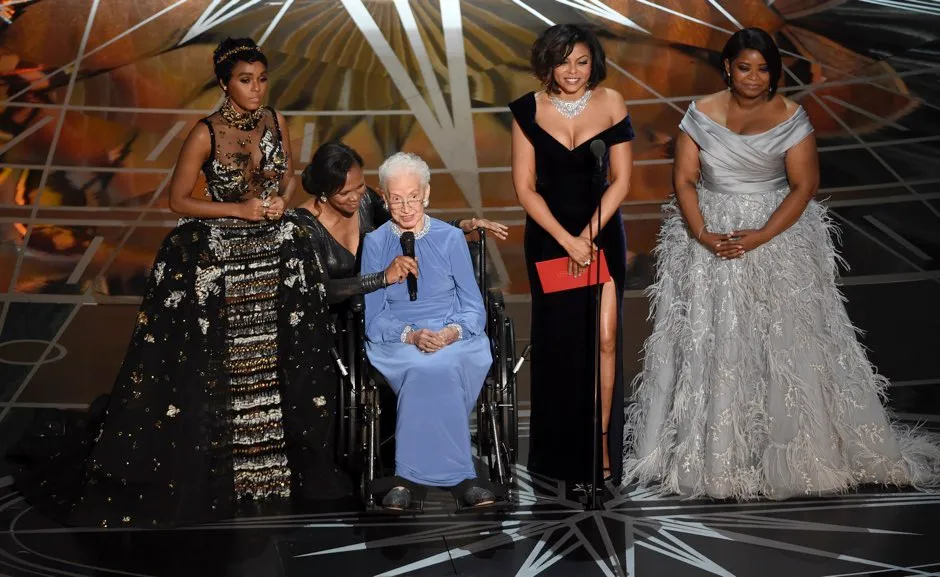- Katherine Johnson was one of NASA's early 'human computers' working on rocket trajectories.
- She was a central character in the Oscar-nominated historical film Hidden Figures.
- Awarded the Presidential Medal of Freedom by President Barack Obama in 2015.
Katherine Johnson, a mathematician who worked on NASA's early space missions and was portrayed in the film Hidden Figures, has died at the age of 101.
She died on Monday of natural causes at a retirement community in Newport News, Virginia, family lawyer Donyale YH Reavis told the Associated Press.
NASA administrator Jim Bridenstine tweeted that the NASA family “will never forget Katherine Johnson’s courage and the milestones we could not have reached without her. Her story and her grace continue to inspire the world”.
She was one of the “computers” who solved equations by hand during NASA's early years and those of its precursor organisation, the National Advisory Committee for Aeronautics.
Ms Johnson and other black women initially worked in a racially segregated computing unit in Hampton, Virginia, that was not officially dissolved until NACA became NASA in 1958. Signs had dictated which toilets the women could use.

She focused on planes and other research at first. But her work at NASA's Langley Research Centre eventually shifted to Project Mercury, the nation’s first human space programme.
“Our office computed all the (rocket) trajectories,” she told the Virginian-Pilot newspaper in 2012. “You tell me when and where you want it to come down, and I will tell you where and when and how to launch it.”
Read more about women in science history:
- Ladies who launch: the women behind the Apollo Program
- Ada Lovelace: a mathematician, a computer scientist and a visionary
- 10 amazing women in science history you really should know about
- Wally Funk: a story of sexism in the race for space
In 1961, Ms Johnson did trajectory analysis for Alan Shepard’s Freedom 7 Mission, the first to carry an American into space.
The next year, she manually verified the calculations of a nascent NASA computer, an IBM 7090, which plotted John Glenn’s orbits around the planet.
“Get the girl to check the numbers,” a computer-sceptical Glenn had insisted in the days before the launch.

“Katherine organised herself immediately at her desk, growing phone-book-thick stacks of data sheets a number at a time, blocking out everything except the labyrinth of trajectory equations,” Margot Lee Shetterly wrote in her 2016 book Hidden Figures, on which the film is based.
“It took a day and a half of watching the tiny digits pile up: eye-numbing, disorienting work,” Shetterly wrote.
Shetterly told the Associated Press on Monday that Ms Johnson was “exceptional in every way”.
I don't have a feeling of inferiority. Never had. I'm as good as anybody, but no better
Katherine Johnson
“The wonderful gift that Katherine Johnson gave us is that her story shined a light on the stories of so many other people,” Shetterly said.
“She gave us a new way to look at black history, women’s history and American history.”
Shetterly noted that Ms Johnson died during Black History Month and a few days after the anniversary of Glenn’s orbits of the Earth on 20 February 1962, for which she played an important role.
“We get to mourn her and also commemorate the work that she did that she’s most known for at the same time,” Shetterly said.
Read more about the Apollo space programme:
- Everything you ever wanted to know about the Apollo programme
- 50 beautiful photos of the Moon landing missions from the Project Apollo Archives
- How 22kg of lunar rocks delivered by Apollo 11 changed our understanding of how the Moon formed
- Apollo 11 Space Mission: 60 seconds from disaster
- Saturn V: Inside the rocket that launched Apollo 11 to the Moon
Ms Johnson considered her work on the Apollo programmeto be her greatest contribution to space exploration. Her calculations helped the lunar lander rendezvous with the orbiting command service module. She also worked on the Space Shuttle programme before retiring in 1986.
She and her co-workers had been relatively unsung heroes of America’s Space Race. But in 2015, President Barack Obama awarded Ms Johnson — then 97 — the Presidential Medal of Freedom, the nation’s highest civilian honour.

The Hidden Figures book and film followed, telling the stories of Ms Johnson, Dorothy Vaughan and Mary Jackson, among others.
Ms Johnson was portrayed in the film by actress Taraji P Henson. The film was nominated for a Best Picture Oscar and grossed more than $200m worldwide.
In 2017, Ms Johnson was brought on stage at the Academy Awards ceremony to thunderous applause. Jackson and Vaughan had died in 2005 and 2008 respectively.

She was born Katherine Coleman on 26 August 1918, in White Sulphur Springs, West Virginia, near the Virginia border.
She taught at black state schools before becoming one of three black students to integrate West Virginia’s graduate schools in 1939.
She left after the first session to start a family with her first husband, James Goble, and returned to teaching when her three daughters grew older.
In 1953, she started working at the all-black West Area Computing unit at what was then called Langley Memorial Aeronautical Laboratory in Hampton.
Ms Johnson’s first husband died in 1956, and she married James A Johnson in 1959.
She spent her later years encouraging students to enter the fields of science, technology, engineering and mathematics.
Looking back, she said she had little time to worry about being treated unequally.
“My dad taught us ‘you are as good as anybody in this town, but you’re no better’,” she told NASA in 2008.
“I don’t have a feeling of inferiority. Never had. I’m as good as anybody, but no better.”
